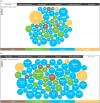'Antibiotic footprint' as a communication tool to aid reduction of antibiotic consumption
- PMID: 31074489
- PMCID: PMC6640305
- DOI: 10.1093/jac/dkz185
'Antibiotic footprint' as a communication tool to aid reduction of antibiotic consumption
Abstract
'Superbugs', bacteria that have become resistant to antibiotics, have been in numerous media headlines, raising awareness of antibiotic resistance and leading to multiple action plans from policymakers worldwide. However, many commonly used terms, such as 'the war against superbugs', risk misleading people to request 'new' or 'stronger' antibiotics from their doctors, veterinary surgeons or pharmacists, rather than addressing a fundamental issue: the misuse and overuse of antibiotics in humans and animals. Simple measures of antibiotic consumption are needed for mass communication. In this article, we describe the concept of the 'antibiotic footprint' as a tool to communicate to the public the magnitude of antibiotic use in humans, animals and industry, and how it could support the reduction of overuse and misuse of antibiotics worldwide. We propose that people need to make appropriate changes in behaviour that reduce their direct and indirect consumption of antibiotics.
© The Author(s) 2019. Published by Oxford University Press on behalf of the British Society for Antimicrobial Chemotherapy.
Figures



Comment in
-
Comment on: 'Antibiotic footprint' as a communication tool to aid reduction of antibiotic consumption.J Antimicrob Chemother. 2019 Sep 1;74(9):2822. doi: 10.1093/jac/dkz251. J Antimicrob Chemother. 2019. PMID: 31203363 Free PMC article. No abstract available.
-
Comment on: 'Antibiotic footprint' as a communication tool to aid reduction of antibiotic consumption.J Antimicrob Chemother. 2019 Nov 1;74(11):3404-3406. doi: 10.1093/jac/dkz320. J Antimicrob Chemother. 2019. PMID: 31314102 No abstract available.
References
-
- Review on Antimicrobial Resistance. Antimicrobial Resistance: Tackling a Crisis for the Health and Wealth of Nations https://amr-review.org/sites/default/files/160525_Final%20paper_with%20c....
-
- Mendelson M, Balasegaram M, Jinks T. et al. Antibiotic resistance has a language problem. Nature 2017; 545: 23–5. - PubMed
-
- WHO. Antibiotic Resistance: Multi-Country Public Awareness Survey. http://apps.who.int/medicinedocs/documents/s22245en/s22245en.pdf.

